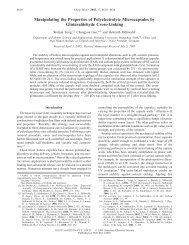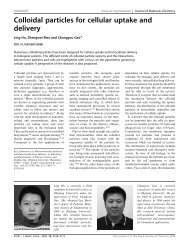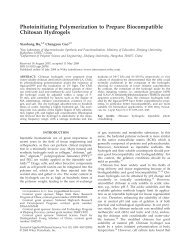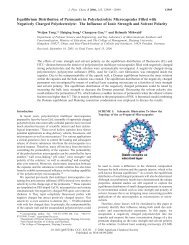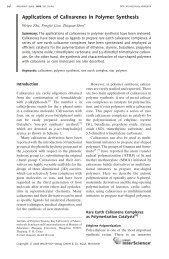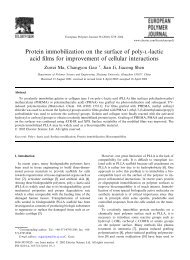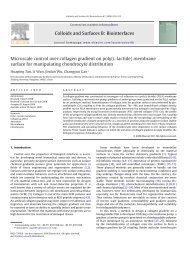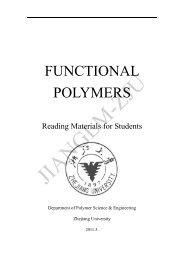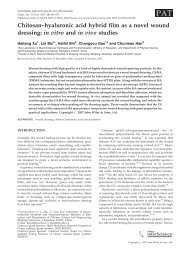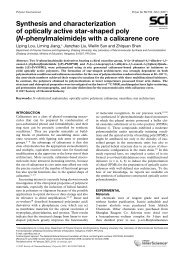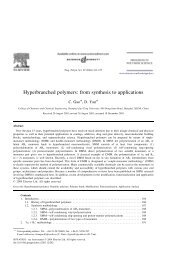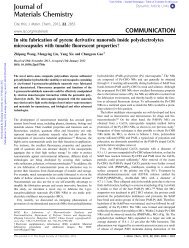Preparation and properties of ionically cross-linked chitosan ...
Preparation and properties of ionically cross-linked chitosan ...
Preparation and properties of ionically cross-linked chitosan ...
Create successful ePaper yourself
Turn your PDF publications into a flip-book with our unique Google optimized e-Paper software.
H. LIU AND C. GAOdrug toxicity as a result <strong>of</strong> long term application, for examplearthritis damage for children, various sustained release carrierssuch as microcapsules, gels <strong>and</strong> liposomes have been developed.Yet so far less attention has been given to the nanoparticlecarriers, in particular the <strong>chitosan</strong> nanoparticles.EXPERIMENTALMaterialsChitosan (CS, M h ¼ 620 kDa, degree <strong>of</strong> deacetylation ¼ 90%,viscosity ¼ 115 cps) is a commercial product <strong>of</strong> Haidebei HalobiosCo., Ltd. (Ji’nan, China). Sodium tripolyphosphate (TPP) waspurchased from Dongsheng Chemical Reagent Factory (Wenzhou,China). Cipr<strong>of</strong>loxacin hydrochloride (CH, C 17 H 18 FN 3 O 3 HClH 2 O)was purchased from Zhejiang Medicine Co. Ltd., XinchangPharmaceutical Factory (Shaoxing, China). Phosphotungstic acidwas purchased from Sinopharm Group Chemical Reagent Co., Ltd.(Shanghai, China). All other chemicals were <strong>of</strong> analytical grade <strong>and</strong>used as received. The water used in all experiments was tripledistilled.<strong>Preparation</strong> <strong>of</strong> the <strong>chitosan</strong> nanoparticlesThe nanoparticles were obtained based on ionic gelation <strong>of</strong> TPPwith <strong>chitosan</strong>. [10] Briefly, <strong>chitosan</strong> <strong>and</strong> TPP were dissolved inacetic acid <strong>and</strong> triple distilled water to obtain solutions <strong>of</strong> 1.0–5.0<strong>and</strong> 0.25–2.0 mg/ml, respectively. The <strong>chitosan</strong> nanoparticleswere obtained upon addition <strong>of</strong> 14 ml TPP solution into 35 ml<strong>chitosan</strong> solution under mild mechanical stirring (550 rpm) atroom temperature. The drug-loaded nanoparticles were similarlyprepared by using a <strong>chitosan</strong> solution containing the drug.CharacterizationMorphological examination <strong>of</strong> the <strong>chitosan</strong> nanoparticles wasperformed by transmission electron microscopy (TEM) (JEOLJEM-200CX, Japan). The sample was stained with 2% (w/v)phosphotungstic acid <strong>and</strong> a drop <strong>of</strong> the sample was applied ontoa carbon-coated copper meshwork, <strong>and</strong> dried at roomtemperature. The acceleration voltage was 100 kV. Zeta potential<strong>of</strong> the particles was recorded on a Zetasizer 2000. Each value wasaveraged from three parallel measurements.The particle size was measured by dynamic light scattering(DLS) (90 Plus/BI-MAS). The wavelength <strong>of</strong> laser is 658 nm.Brookhaven’s unique dust filter algorithm can remove theinfluence <strong>of</strong> a contaminating fraction <strong>of</strong> large particles (dust).Processing the fluctuating signal with a state-<strong>of</strong>-the-art digitalauto-correlator yields the particle’s diffusion coefficient, fromwhich the equivalent spherical particle size is calculated using theStokes–Einstein equation. When a broad distribution <strong>of</strong> spheres ispresent in the samples, the following auto-correlation function isused:ZgðtÞ ¼ GðGÞe Gt dGan average diameter <strong>and</strong> a distribution width (polydispersity) areobtained. It has to be noted that the most important pieces <strong>of</strong>information obtained in photon correlation spectroscopy usingany multimodal distribution analysis are the positions <strong>of</strong> thepeaks <strong>and</strong> the ratio <strong>of</strong> the peak areas. The widths <strong>of</strong> the peaks,however, are not particularly reliable, since they will narrow,typically, with increasing duration <strong>of</strong> experiment until a limit isreached. For more details, the readers can refer to the machinemanual. Each measurement was taken for 1 min with a 908 fixedangle detector. The size was averaged from five parallelmeasurements.Stability <strong>of</strong> the <strong>chitosan</strong> nanoparticlesThe stability <strong>of</strong> the <strong>chitosan</strong> nanoparticles obtained at differentfabricating conditions was examined in terms <strong>of</strong> the particle size.The nanoparticle suspensions were stored at 48C <strong>and</strong> the sizes <strong>of</strong>the nanoparticles were monitored by DLS.Biocompatibility <strong>of</strong> the <strong>chitosan</strong> nanoparticlesIn vitro cell culture was performed to determine the biocompatibility<strong>of</strong> the as-prepared <strong>chitosan</strong> nanoparticles. The <strong>chitosan</strong>nanoparticles were sterilized by UV irritation before cell culture.Human dermal fibroblasts were isolated from foreskins <strong>and</strong>routinely exp<strong>and</strong>ed. [20] The cells were cultured at 378C, in 5% CO 2 ,<strong>and</strong> 95% humidity in DMEM supplemented with penicillin (100 U/ml), streptomycin (100 mg/ml), <strong>and</strong> 10% fetal bovine serum (FBS)(complete medium), which was changed every 3 days. Cells werepassaged at confluence <strong>and</strong> the 4–8th passage <strong>of</strong> fibroblasts witha density <strong>of</strong> 2 10 5 /ml were seeded in a 96-well polystyreneplate. After 24 hr, 60 ml <strong>of</strong> nanoparticle suspension was addedinto each well. The final nanoparticle concentration was highenough for close contact between the cells <strong>and</strong> the nanoparticles.The culture medium was changed every 2 days. Meanwhile,normal culture medium was used in parallel as a negative control.The cell proliferation was measured by methylthiazoletetrazolium(MTT) assay. [21] The absorbance was recorded at a wavelength <strong>of</strong>570 nm by a microplate reader (Bio-Rad model 550). Threeparallel samples were analysed <strong>and</strong> data were expressed asmean st<strong>and</strong>ard deviation.Quantification <strong>of</strong> the relative CH amount in the <strong>chitosan</strong>nanoparticlesThe prepared nanoparticle suspension containing the CH wascentrifugated at 12,000 rpm for 70 min to obtain the supernatant,which was diluted over hundreds <strong>of</strong> times <strong>and</strong> the absorbance at276 nm was recorded by a UV–vis spectrophotometer (ShimadzuUV-2550). The supernatant <strong>of</strong> blank nanoparticles was obtainedunder the same conditions <strong>and</strong> used as a control. Theconcentration <strong>of</strong> CH in the supernatant was quantified byreferring to a calibration curve recorded from a known amount <strong>of</strong>CH at the same condition. A lower concentration found in thesupernatant implies a higher loading efficiency in the <strong>chitosan</strong>nanoparticles.614where G is related to the relaxation <strong>of</strong> the fluctuations. Forobtaining information from this equation, a method <strong>of</strong> Cumulantanalysis is applied. To get the solution, an approximation is usedby the non-negative constrained least squares (NNLS) algorithm.Moreover, Mie theory is used to calculate the weight <strong>and</strong> numberfractions from the intensity fractions. For routine determinations,Release <strong>of</strong> CHCH release was performed using a dialysis technique. The CHloaded <strong>chitosan</strong> nanoparticles were centrifugated at 12,000 rpmfor 70 min to obtain the nanoparticle precipitate, which waswashed with water twice. The nanoparticles were transferred intowww.interscience.wiley.com/journal/pat Copyright ß 2008 John Wiley & Sons, Ltd. Polym. Adv. Technol. 2009, 20 613–619



